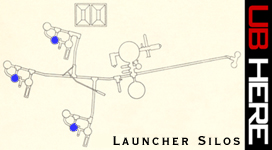ICBM
Idiocy
The
Titan I sites as they exist today are pretty hazardous really. I
believe I've tried to make that point at other times throughout this
site. Its true, it really is, and if you're the sort to break
into such places (an act that even I cannot condone even a little bit)
ill-prepared and over-confident of your abilities to anticipate and
avoid the many obstacles and potentially-injurious aspects of the dank
darkness that are the defunct Titan I sites, I must urge you never,
ever to do what I describe below. It was unequal parts
curiosity, stupidity and outright insanity. I figure a
distribution of approximately 30%/50%/20% of the aforementioned
attributes.
It
was somewhere around the Fall of 2003 and I knew that I was going to
be losing my access to 724-C soon as it was going to become property
of someone else and my services as caretaker/tour guide were not
needed by the new owner.
I
had crawled all over just about every inch of the site including the
water-logged launcher #3, and the claustrophobic launcher air
filtration facility along with the submerged propellant terminal #1
and adjoining LOX tunnel-- even going to far as to squeeze through
openings only 18" in diameter to see the fuel tunnel and the silo
side of the LOX tunnel firewall.
Most
times I was completely alone and armed with a flashlight when
exploring. If anything had happened to me, it would likely have
been days or weeks before anyone thought to look for me, and much
longer before anyone thought to check the missile site for my mortal
remains.
There
was, despite my adventurous and explorative nature, one place I had
seen precious little of, and another I had not seen at all. With
my mind completely gone, I set about planning on how to see,
first-hand these last few places where previously I had not dared to
tread.
I
am of course speaking of the missile silos, and more specifically, the
catwalk level of the silos. This is the once man-accessible area
at the very top inside the silos where the elevator motor, crib locks,
leveling jacks and to me, many unknowns still existed.
The
Plan:
The
blueprints I had show little of this area, and absolutely nothing of
the physical equipment at the silo catwalk level. Since the
bottom of the silos-- the Holy Grail of the Titan I sites-- were all
filled with water, the next best thing would be to ascend to the silo
cap and see that for myself.
I
had done my reconnaissance and visited each launcher multiple times
and gotten many pictures, and so armed with this information, I began
to plan my assault.
|
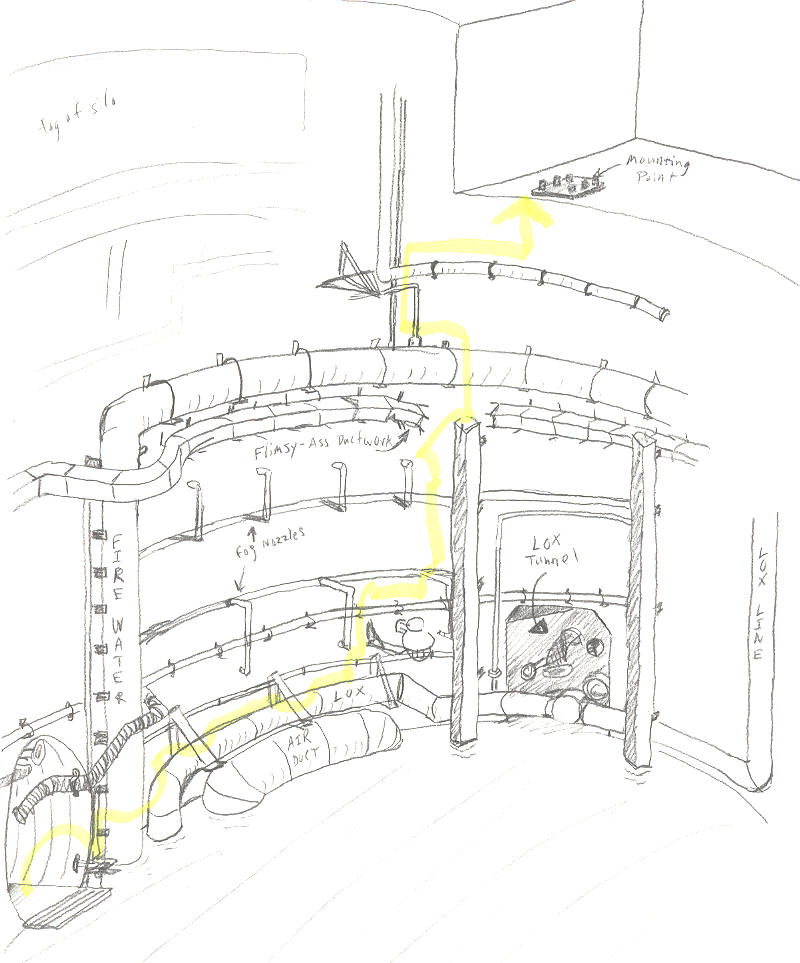
A
pencil sketch of my insane assault on 724-C's silo #3 made about 2 days
after my successful expedition. The reason this was done after the
fact is that until I made the trip, many of the details were not well
known or known at all.
|
Site
724-C's launcher silos were all in different conditions and at vastly
different water levels during my time there.
-
Silo
#1 was flooded to a depth of about 70' and seemed to be missing
the most of all 3 silos. The LOX and Fuel cribs were gone
and it appeared as though a lot more features had been removed
from the walls.
-
Silo
#2 had the least water in it and was flooded to a depth of around
40 to 50 feet but retained the fuel crib for some reason when silo
#1 and silo #3 did not. As a result, you could see a lot
more of silo #2, though there was not much to see 30' below the
personnel tunnel.
-
Silo
#3 was flooded up to the personnel tunnel (about 100' deep) but
retained some features of the LOX piping that the other 2 silos
did not.
|
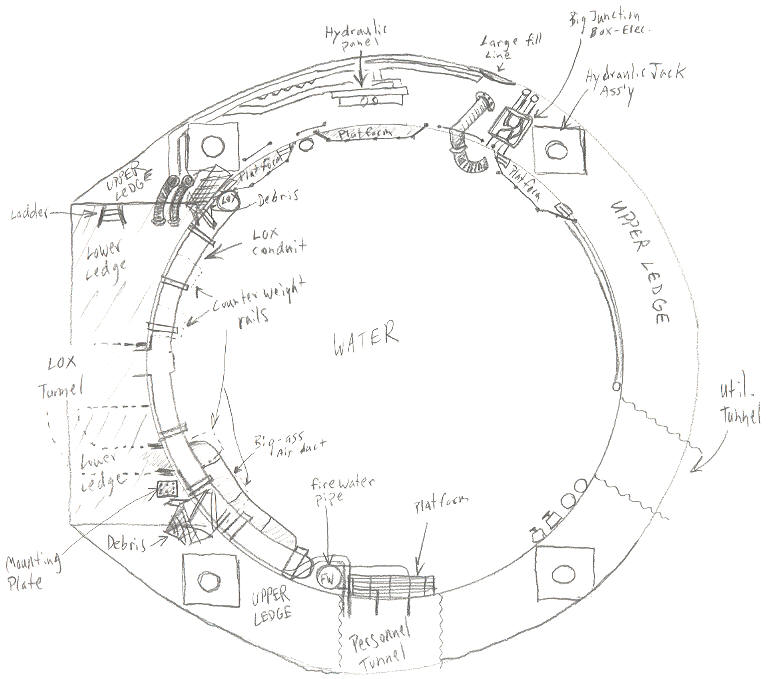
An
overhead sketch of silo #3 made after surviving one of the dumbest
endeavors of my entire life, which I had very nearly shortened by the
execution of said endeavor.
Let
me remind you of the absolute darkness as I climbed in the dark
clutching a flashlight in one hand while wearing no safety gear
whatsoever.
|
As
silo #3 had the most water in it at 100' feet of flooding, I chose it
for safety reasons. If you're going to fall in water, make it as
short a fall as possible!
Looking
over my photos and blueprints I plotted a course that would take me
(see highlighted route in the first sketch above) around a large water conduit
near the personnel tunnel and onto a large air duct which I could
traverse toward the LOX tunnel and its flanking counter-weight
rails. From that point I would scale the walls using fire
suppression conduit to get as high up as I could. Where the fire
water conduit ended I would scale higher using the counter-weight
rails until I reached 2 critical obstacles: some flimsy ductwork
directly over head and the large water conduit above that. How I
was to surmount these obstacles was uncertain, as was the terrain
beyond and how I might proceed. I was just going to have to see
if I could figure it out.
The
water conduit was of particular concern as it forced me to climb
around something that protruded over 20" into empty space without
any clear idea of what hand holds there were at that point. The
duct work served as an obstacle as it was clearly not safe to climb
on. Fortunately, it was torn away in the area I needed to climb
through.
At
that point, I would be at a point where I could reach the elevator
motor platform which was about 6' lower than the rest of the catwalk
level and would be the most readily available access.
That
was the plan...
The
Stupidity:
Sure
I was an idiot-- no question, but in my defense I did try to plan in
order to make my crazy climb as safe as it could be. In all
honesty, I did a lousy job in the end.
I
attempted to cobble together a rudimentary safety harness and line,
but I used cheap poly rope from a hardware store and a few non man-rated
D-rings. It was crap really. Still, I donned this junk and
began my journey knowing full well I might never be heard from again.
As
proof of my lack of sensibility I informed no one of my intent to make
this climb and I did it completely alone. There I was, a single
(stupid) man with a backpack of tools (in case I found anything worth
taking with me) and film, wearing no safety gear while climbing in
complete darkness with a large flashlight in one hand and a cheap
camera hanging from my neck.
The
potential to fall was enormous, as was the possibility of being
knocked unconscious by such a fall. If such an event were to
occur, my unknown whereabouts coupled with the very inaccessible
location would have made recovery and identification of my remains
very difficult and unlikely to happen in short order. We're
talking dental records here...
This
the where my lack of skill with photographic equipment and my possession
of cheap, crappy camera equipment become quite lamentable.
Either over or under-exposed, always grainy, I wish I could say the
images get better as I progressed, but sadly, no, they do not.
The
Insanity:
I
reached the entrance to silo #3 and put on my ridiculous (and
doubtlessly quite ineffectual) harness and backpack of tools, checked
to ensure I had film, replacement batteries, a backup light and took a
deep breath.
I
easily skirted the vertical pipe and traversed the ductwork as
planned. Climbing the fire suppression pipes was no problem
either.
|
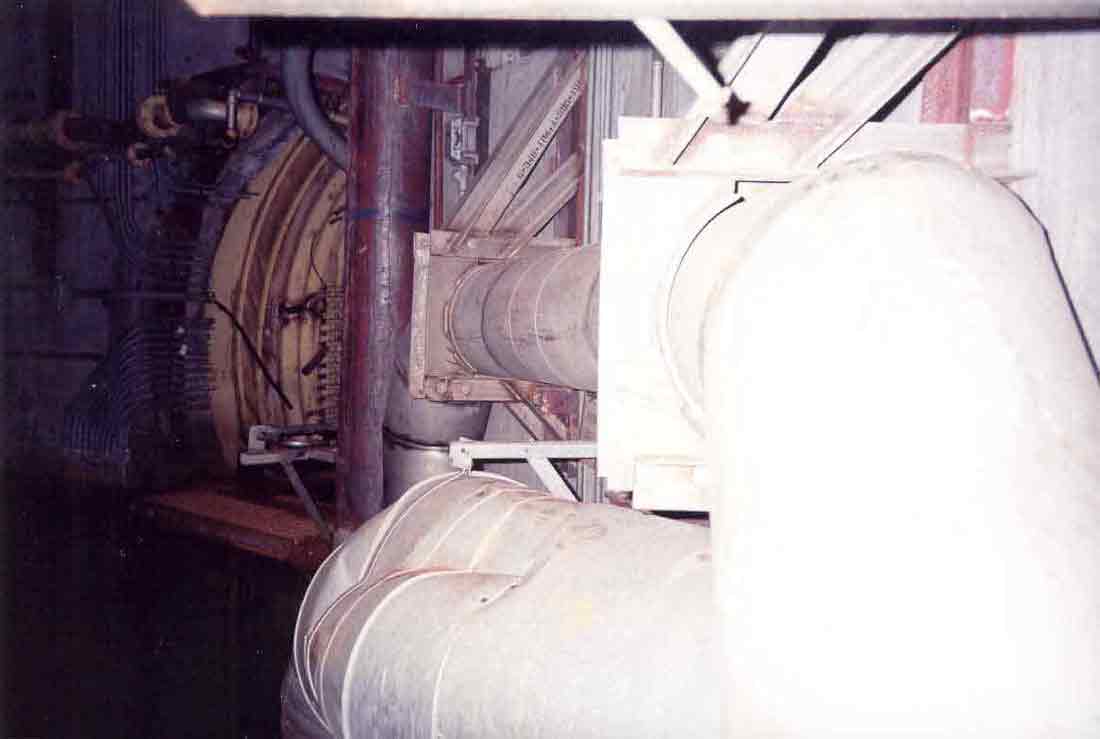
Silo
#3 as viewed from atop the LOX line near its emergence from the LOX
tunnel. This shot is terribly over-exposed but with my cheap,
crummy camera I am thankful that any image was produced at all.
Sadly, affordable digital cameras were not available at the time.
Affordable to me that is...
|
So
far so good.
|
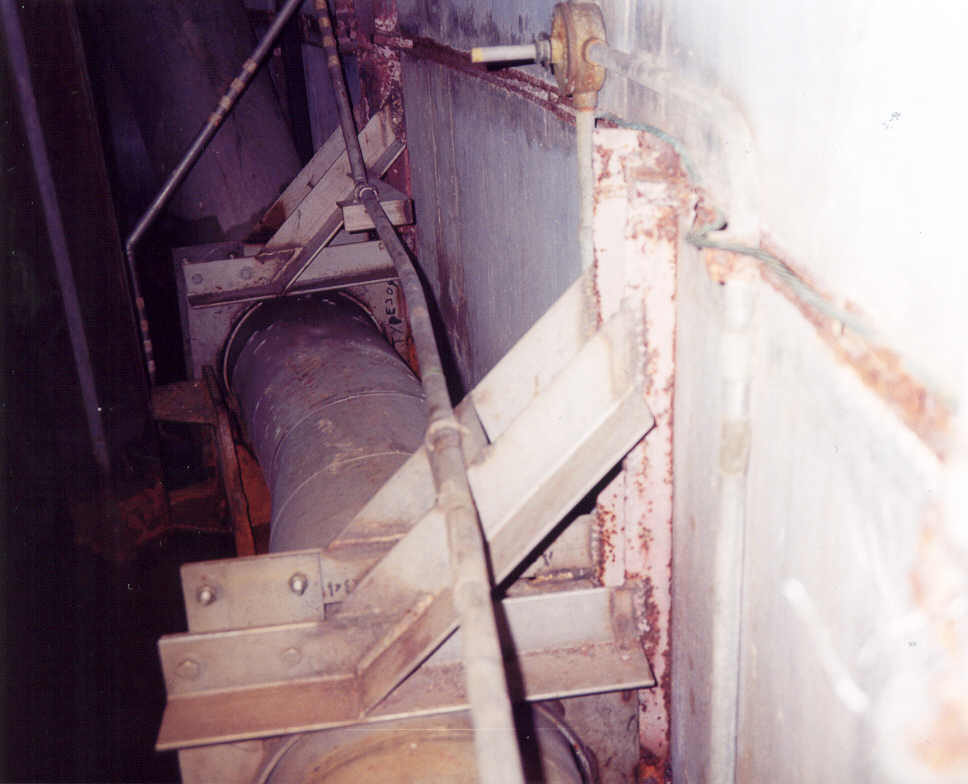
Perched
on top of the LOX line, I took this shot before heading up the
wall. This was the easy part!
|
|
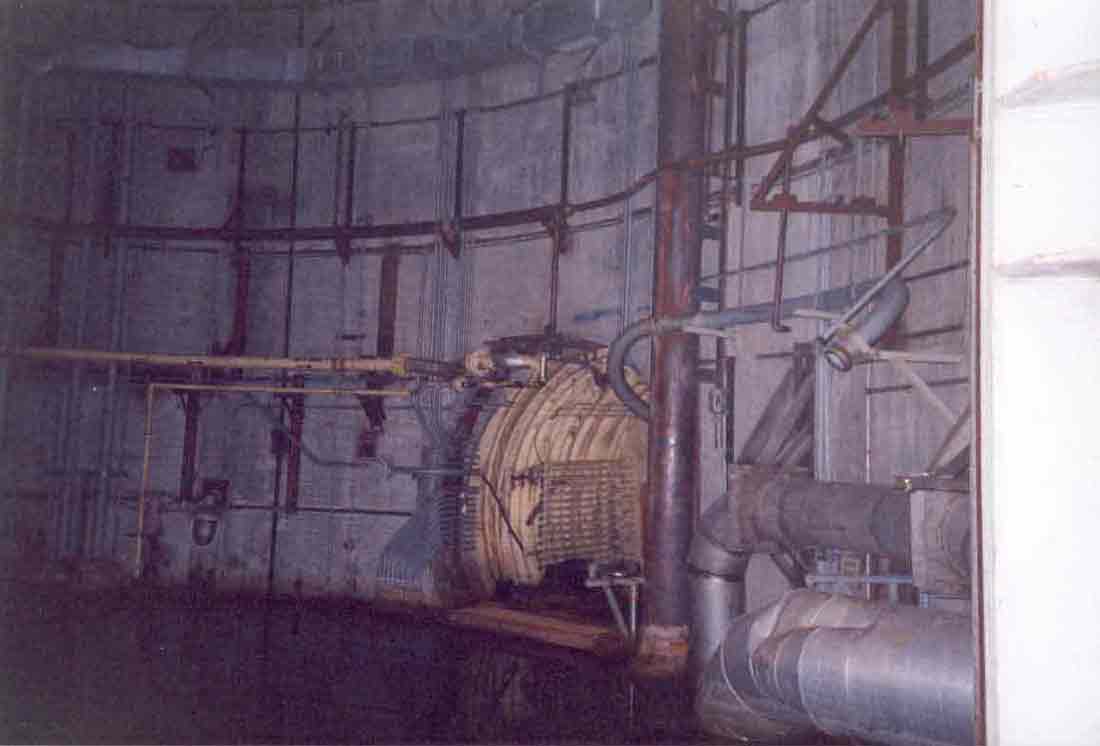
Looking
toward the personnel tunnel from the LOX tunnel of silo #3. This
is roughly the view I had before beginning the climb up the silo
wall. You can see the large air duct (with the big dent) at the
bottom right, with the smaller LOX line above it.
This
shot shows the water level reaching right up to the bottom of the
personnel tunnel.
|
|
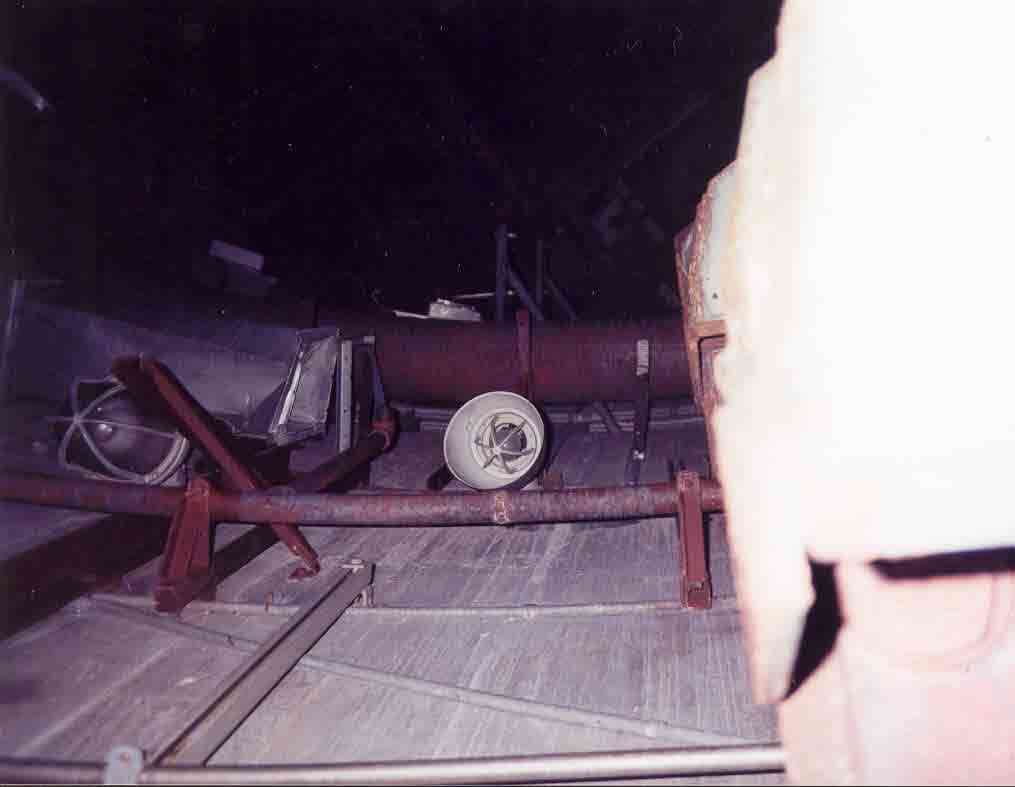
My
view looking up the silo wall toward the large red water pipe (at the
center of the shot) that I would somehow need to get over. The
smaller pipe below it provided a very good foot-hold however.
|
I
took a few pictures along the way and even though I hadn't had any
trouble so far, the danger of my precarious situation was far from
forgotten.
When
I had first arrived at silo #3, my breathing and pulse were
essentially normal, but as I began to make my assault on the silo I
found myself breathing quite rapidly indeed. My pulse had
skyrocketed and pounded in my ears where it was clearly audible to me
in the deathly silence surrounding me. I wondered if I might
suffer a heart attack or possibly even pass out-- an absolute
catastrophe should it occur.
I
ended up not using my lousy harness at all as it seemed more dangerous
to try to affix it to points along the way than to forget it
existed. Luckily the ascent went as planned-- that is until I
reached "the pipe".
Climbing
to the top of the counter-weight rail, the large fire water pipe was about 3 feet
over my head (see next photo). I stood up and tried to see what was up there, but
from where I was I couldn't see the top at all. At this point I
was experiencing raw terror like never before. Sure I had been
frightened many times before but it was always brief, like when
someone jumps out to frighten you or you have a close call while driving: It scares you for a moment and then
you quickly relax again.
This
however, was sustained terror that would not subside and it was far from
over. Why had I not turned back and gone home? I tried to
calm down (and failed) and clenched my teeth and forced myself to
continue.
|
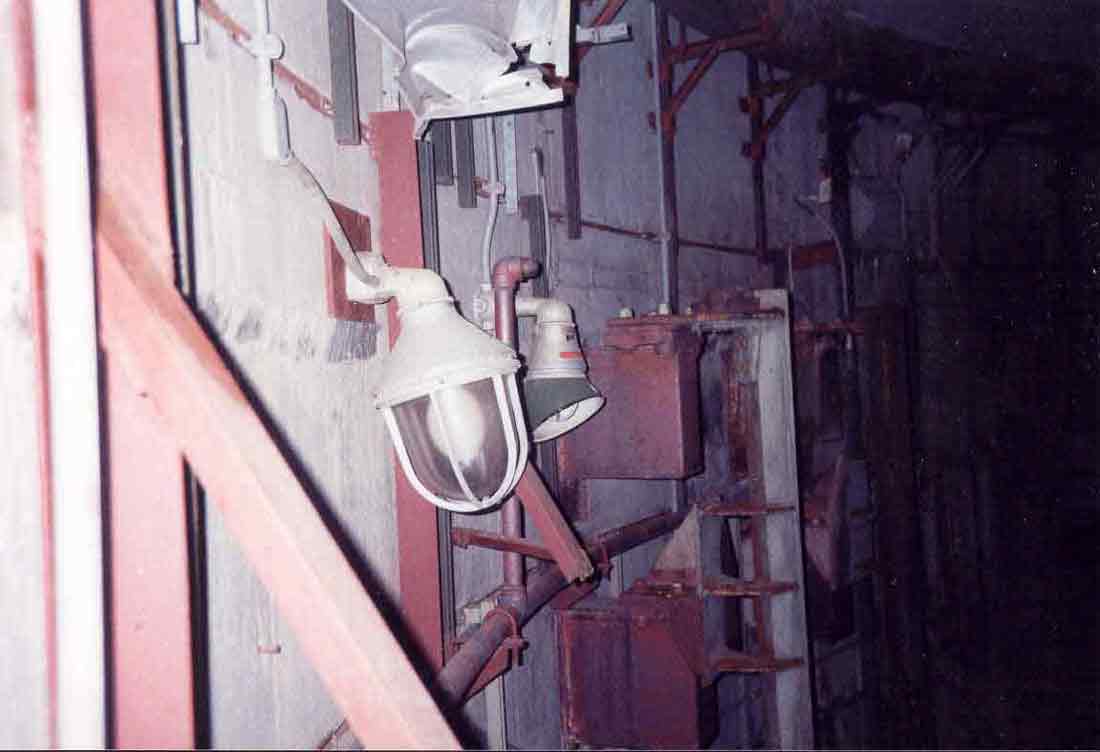
Along
the first leg of my route, I am situated at this point on a stout pipe
support looking at an explosion-proof light fixture. Above this
fixture you can see the remains of the flimsy ductwork which has been
partially torn loose from the wall. Beyond
the light you can see the vertical structure of the counter- weight rail. It was the
top of this rail that would provide a step up to the large water line
above (at upper right).
|
I
stood up on the counter-weight rail and reached
blindly for a hand hold on top of the pipe. Finding a large
U-bolt I could hang onto, I pulled myself up onto the pipe and surveyed the situation.
I
could not
see very well what hand or footholds I might have to climb further up, or
worse yet, back down. Luckily, there was a smaller water pipe
above and some other hardware that gave me ample purchase to haul
myself up further At this point there was about a 3-story drop
between myself and cold, dark water. In that water floated
perhaps 15 or 20 dead rats which had fallen from above after
infiltrating the gaps in the silo doors; I was loathe to join
them.
Climbing
up onto the small pipe, I now stood on a surface about 3" wide
and perhaps 2" away from the silo wall. From there I took
no pictures as I did not dare let go of the pipes I clung to.
Above and to
my right the solid concrete wall dropped down to a ledge that was
about at chest height. This was the area where the enormous
elevator motor platform had been. If I could just find a way to
pull myself up, I would be home free!
Sidling
over to the ledge, I peered across the expanse of bare, flat concrete
and spotted a very lucky break: one corner of the elevator platform
had been mounted about 20" in from the edge of the ledge.
At that spot, 9 stubs of thick threaded bolts protruded upward
jaggedly from a large steel plate where they had been hastily cut
off. The edge of one of the bolts was just within reach, and
although it was perhaps only 5" tall, it appeared to be good
enough to pull myself up and out of the silo.
I
set down my flashlight on the ledge and holding onto the bolt, pulled
myself up with both arms until I could reach and 2nd bolt and then
hauled the rest of my body up onto the dark, dusty ledge where I moved
back away from the abyss and rested a while.
As
I waited for my heartbeat to slow somewhat, this is what I saw around me:
|
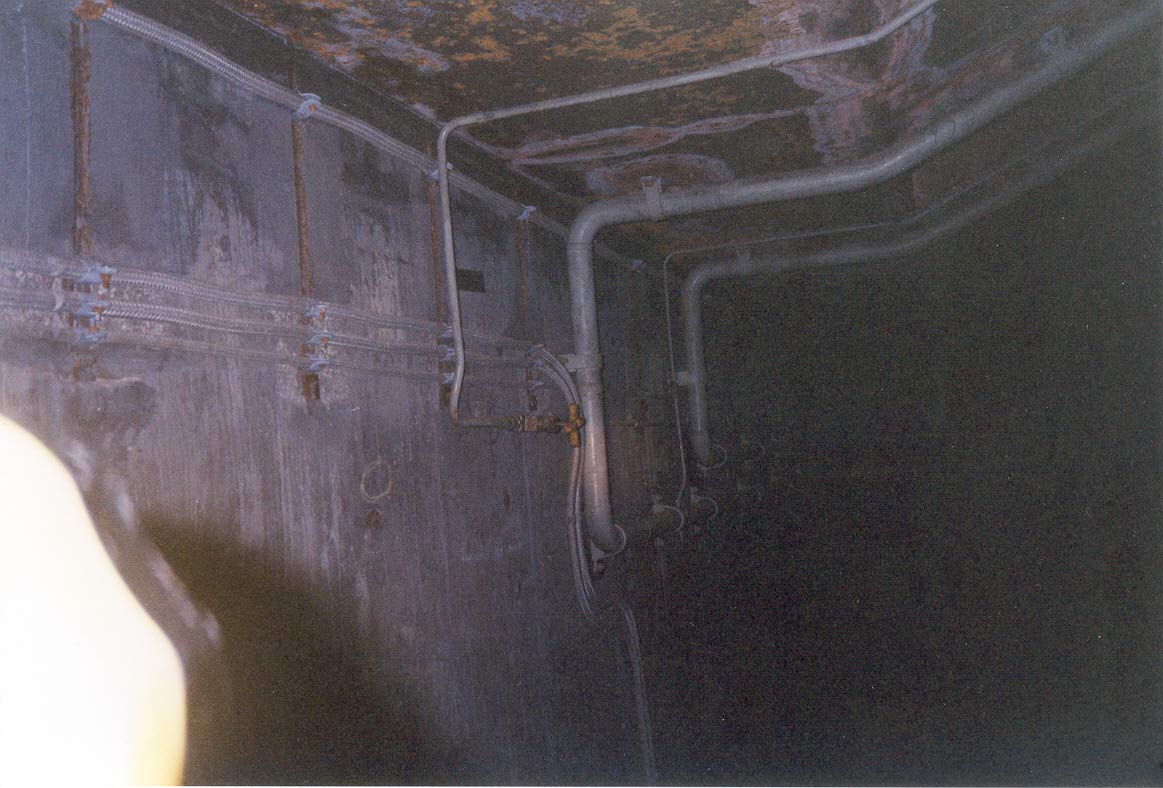
The
former location of the launcher elevator motor platform. The
2 larger pipes visible are the hydraulic lines for one of the silo
doors. This area was once occupied almost entirely by machinery,
but was mostly empty when I arrived. The floor was covered with
tiny cinders from steel cutting torches used by the salvage contractors.
|
Looking
up I saw the rusty steel-clad ceiling streaked with minerals from
water infiltration and dotted and crisscrossed with numerous pipes,
conduits, bolts, hangers, hoses, wires and other hardware.
|
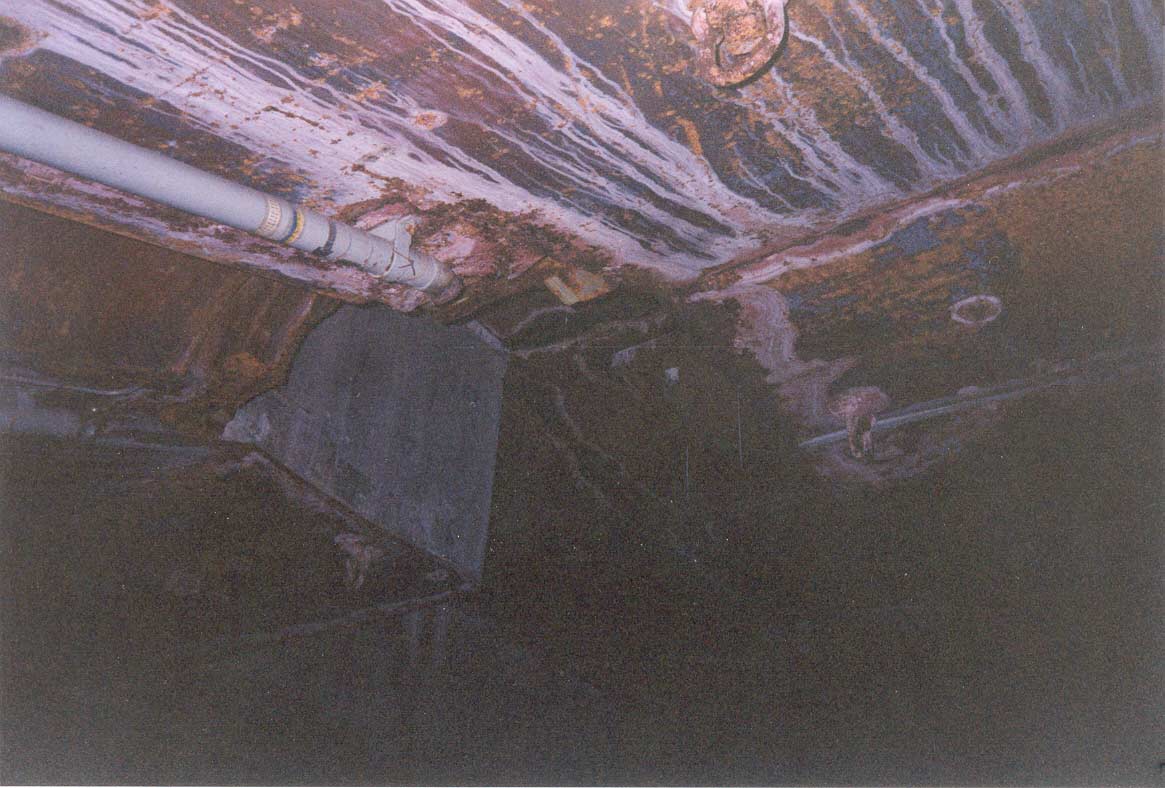
Another
view of the ceiling over the elevator platform. There is a large
channel at left where the hydraulic ram for one of the silo doors used
to be mounted.
|
|
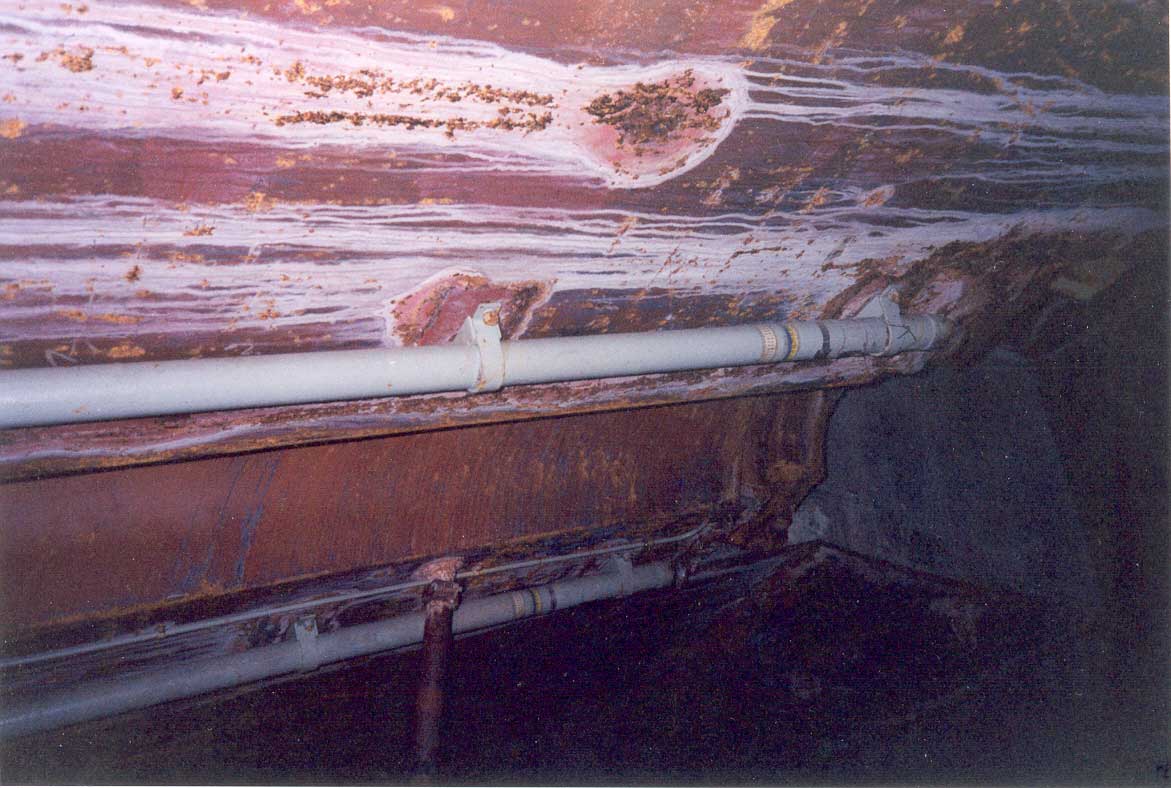
Hydraulic
lines flank the spot where the ram used to be. I was surprised
looking at the blueprints to find that these massive doors only used 1
ram per leaf. Surprising that it was left as a single point of
failure. If a ram failed you simply couldn't launch from that silo
since you couldn't open the bloody doors!
|
Around
where I sat, the actual catwalk was about 6 feet above me on either
side of the platform. I would have to climb one of the walls on
either side of me to see it. There was a section of ladder-like
cable tray already leaning against one wall so I climbed up to see the
rest of the silo.
|
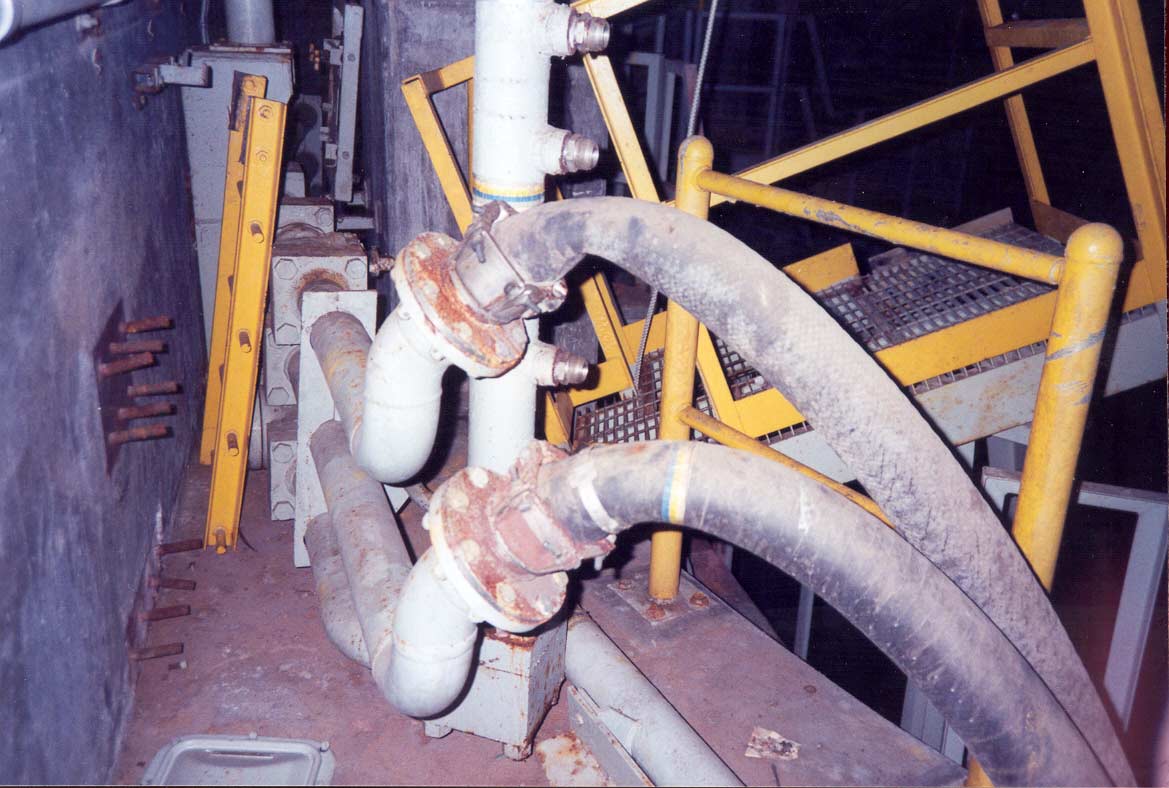
The
catwalk: the first thing I saw were these 2 flexible hydraulic
lines. I believe they went to the cribwork to supply the work
platforms and other functions. You can see that the area is rather
in disarray with platforms askew and in a state of dislocation.
They appear to have been cut free and moved aside to allow the cribwork
to be hoisted out of the silo in one large piece.
|
On
the catwalk I found a cramped and cluttered walkway. There was a
lot of hydraulic piping at this level and there were valves,
connectors and hoses everywhere. At four points around the silo
there were huge concrete "pillow blocks"-- an
outcropping structure to shoulder the load of very heavy movable
structures above-- in this case the entire crib structure and missile.
Each
of these pillow blocks actually protrudes out over the open silo and
since there was a pedestal with a 50-ton vertical jack assembly
mounted on top, you couldn't actually walk behind the pillow
block. Instead, small steel platforms with steps had been
installed to provide
passage around the block over the open silo. However, the first of these was torn away and rested at
a disconcerting angle on top of other structures of uncertain
stability. I wasn't going to walk on those, so instead I climbed
around the vertical jack.
|
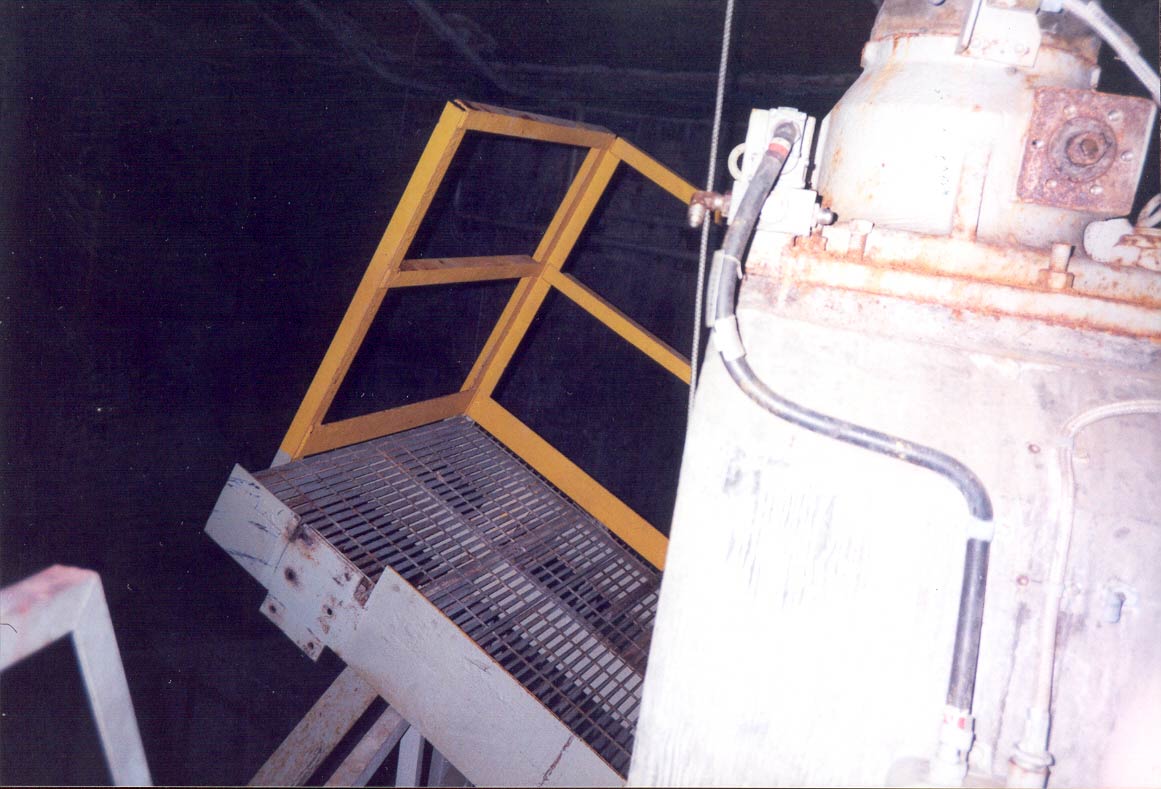
A
pillow block (at right) with an unstable de-installed platform resting
on part of its access platform's railing. I didn't use the
platform, I climbed over the pillow block instead. Much safer.
|
The
four pillow blocks and vertical jacks comprised the crib jacks; these supported the "floating" cribwork and allowed it some
flexibility when the missile was on alert but not in a
countdown. When the missile was set to launch, these jacks and
massive jaw-like crib locks would support and secure the cribwork in
place to provide a solid launch platform.
|
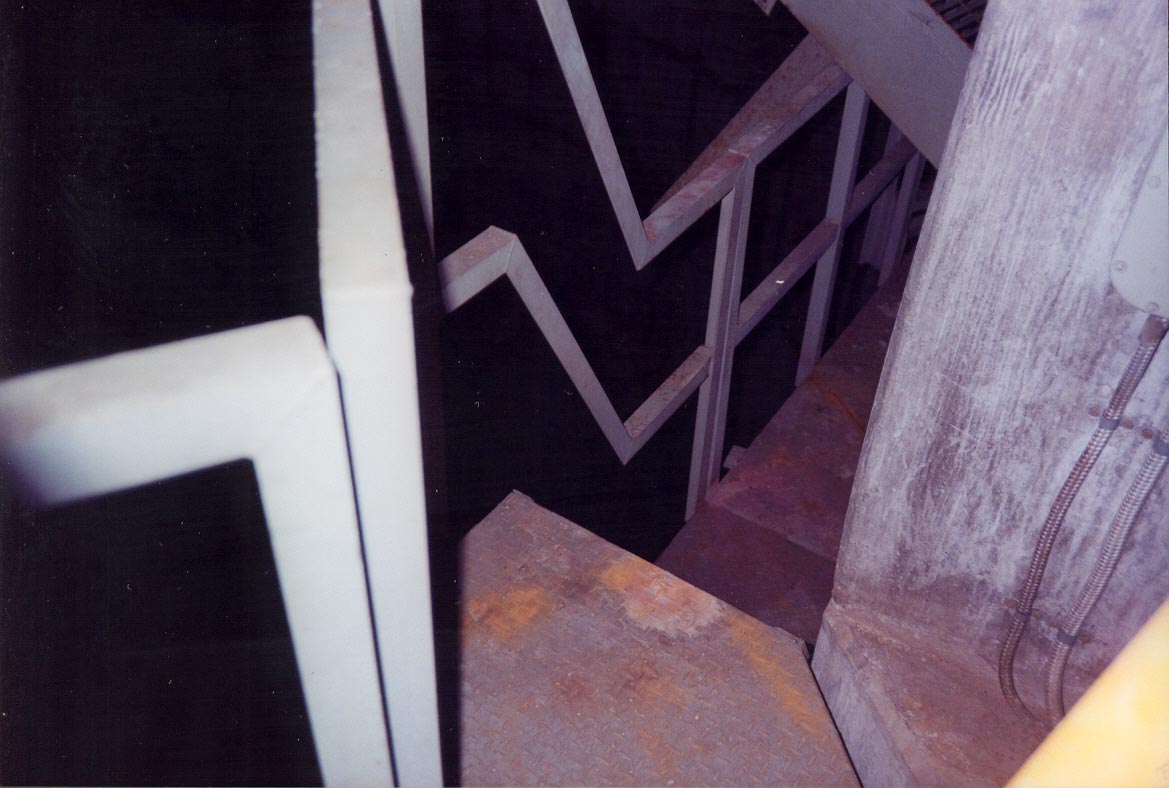
The
platforms that skirt one of the pillow blocks. This one was not
passable. You can see the yawning blackness of the silo in the
background.
|
|
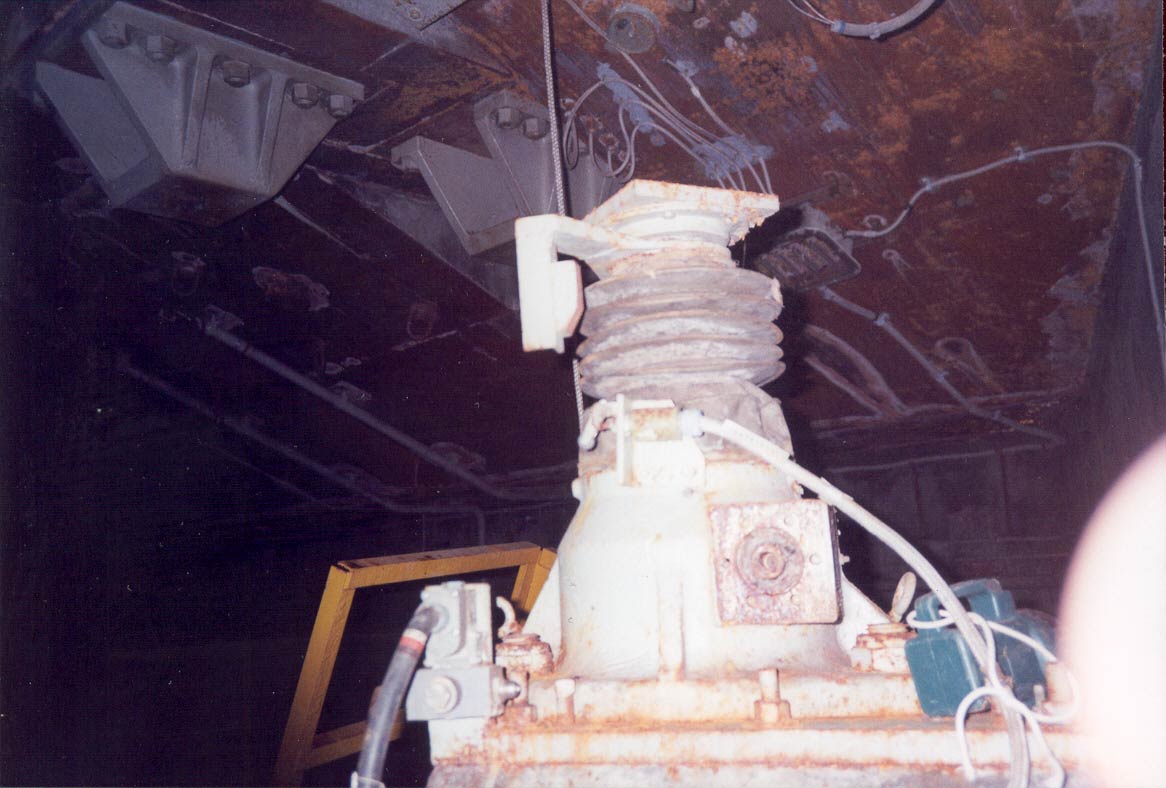
One
of the 50 ton vertical lifting jack assemblies in each quadrant of the
silo. I had to climb over where the green flashlight is resting to
get around it-- far safer than going around the front!
|
My
reward for risking my life multiple times it turned out, was rather a
disappointment really, but suffice to say my curiosity was largely
satisfied. The following pictures are a pretty good
representation of what there is to be seen at the catwalk level
today. Still, I hope it will be of interest to those who don't
care to take completely foolish risks themselves and would otherwise
not be able to see this strange and unusual location any other way.
|
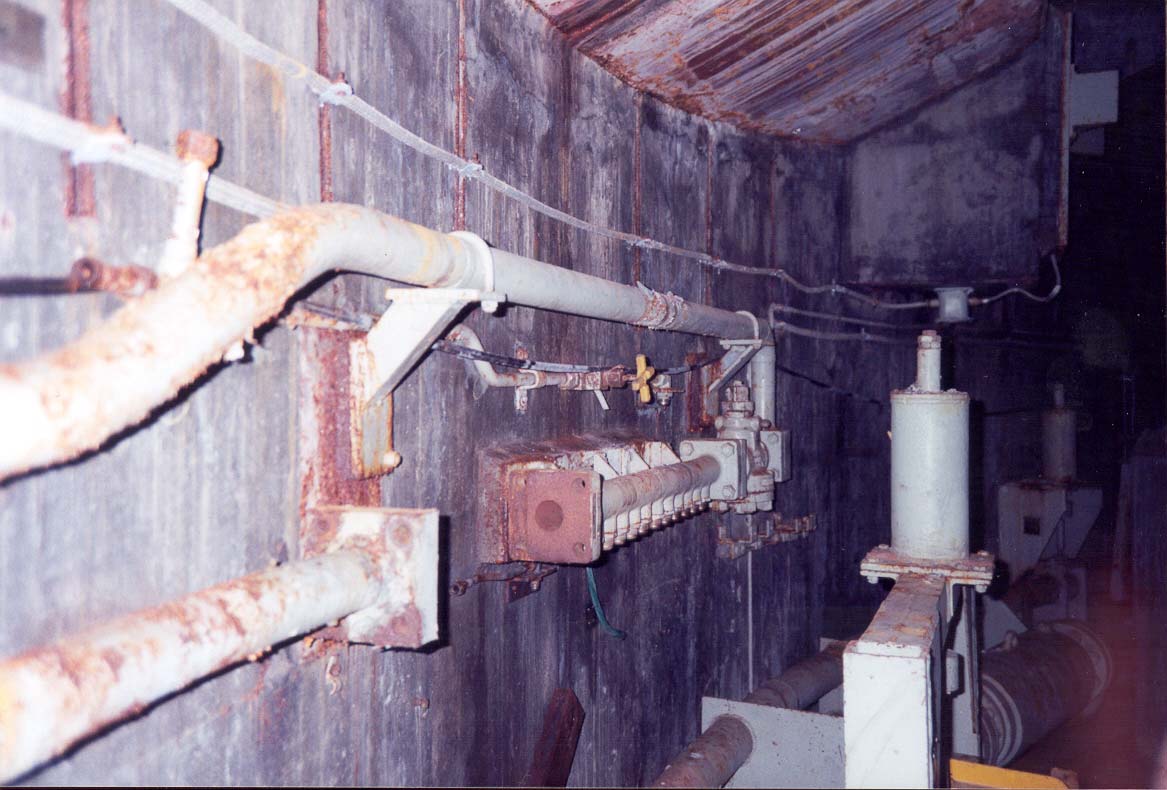
More
hydraulic equipment and a large array of hose connections I believe ran
to the cribwork and supplied other assemblies on the catwalk. This
area was full of piping so I had to climb along the top to pass more
easily.
|
|
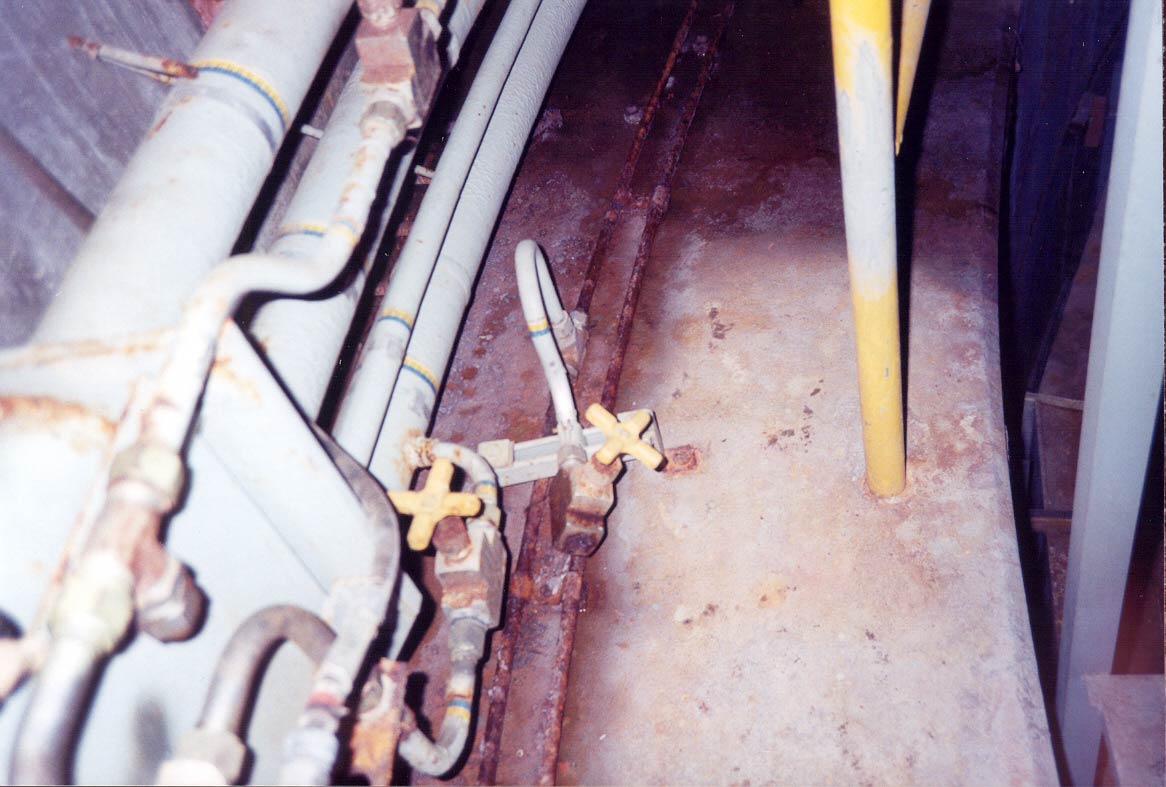
More
hydraulics and valves. The two smaller, rusted pipes ran just
about the entire circumference of the silo and sprouted other small
offshoots such as the one you see here.
|
As
I made my way around the mouth of the silo, I was sure to snap lots of
pictures. I took plenty of time looking around and carefully
choosing interesting shots while I waited for my heart rate to return
to normal (it never really did) as I did so. So after spending
all that time taking pictures and carefully exploring the somewhat
limited scenery, I realized that my film was not advancing and all the
pictures I thought I had taken were in fact lost.
!!@#$!! These pictures were actually taken on my trip back
around the silo to where I had climbed up onto the elevator platform.
I tried to re-capture the shots I took on my way through the first
time, but of course I really felt the lost pictures would have been
better somehow.
|
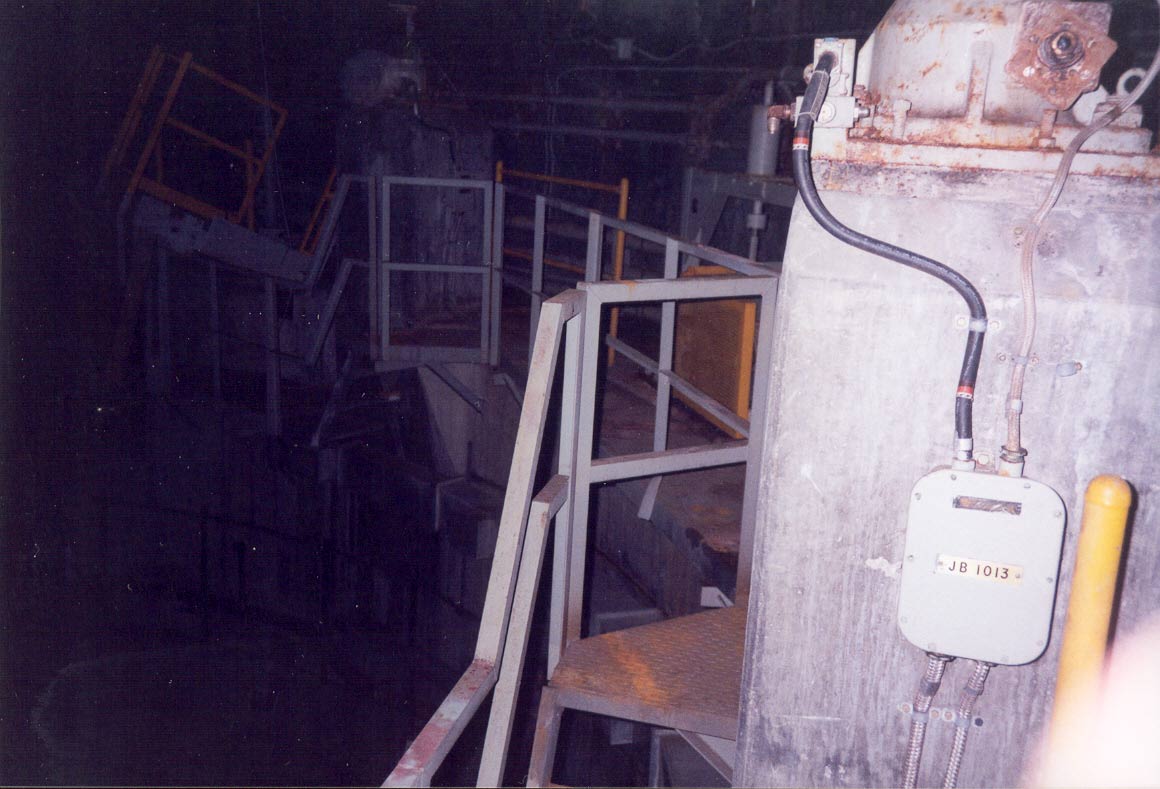
Another
pillow block with a passable catwalk. Still, I found it unnerving
to walk on it.
|
|
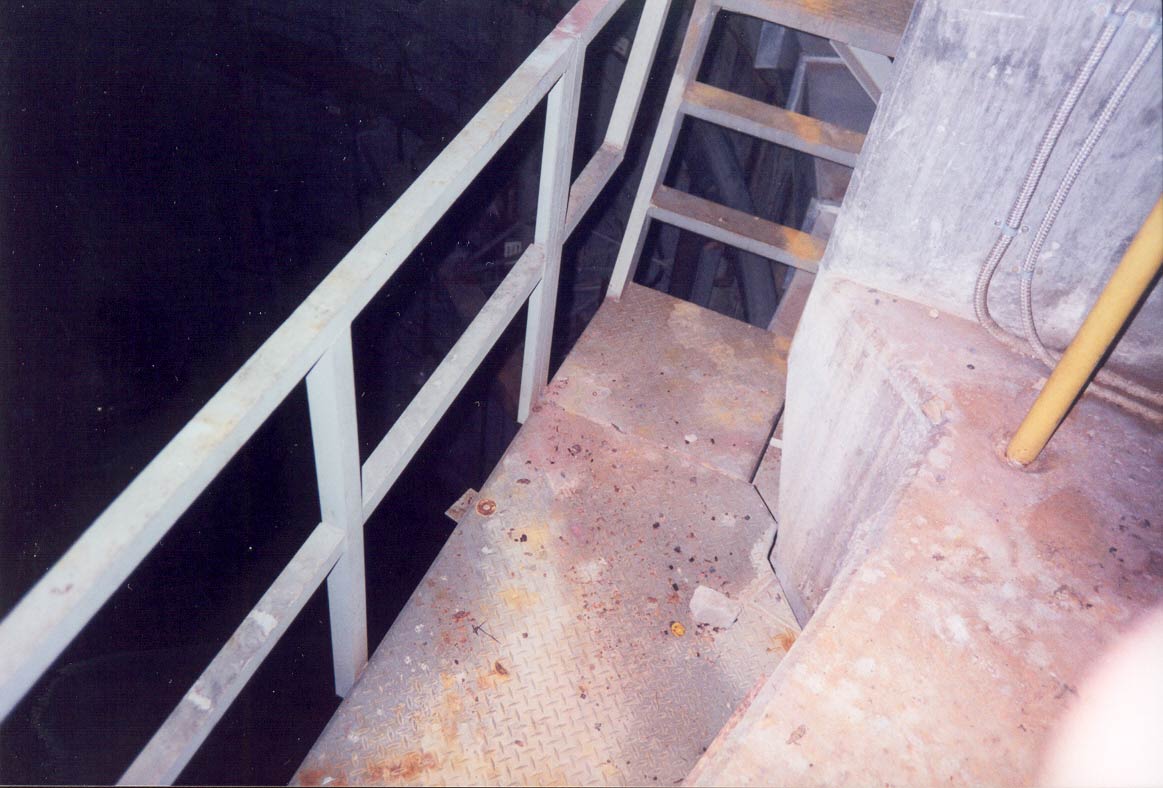
The
narrow catwalk skirting the pillow block
|
|
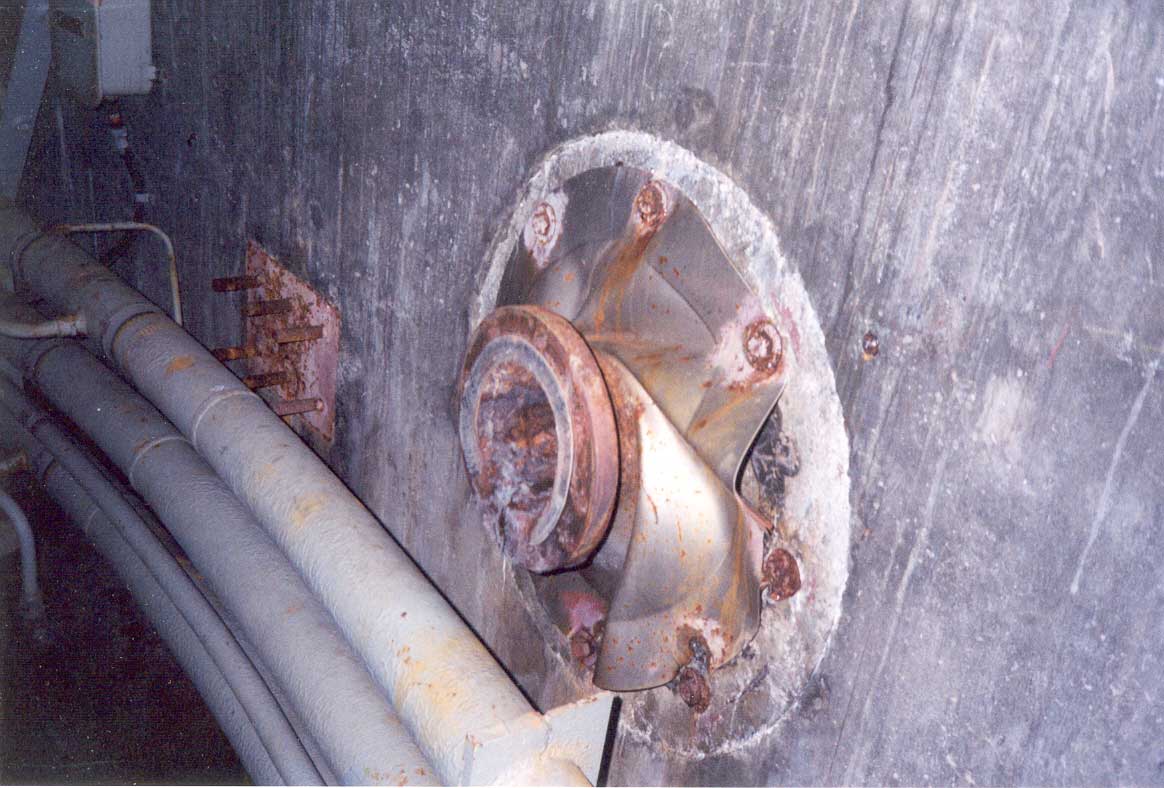
About
half way around the silo there was this pipe which appeared to have been
violently jarred or ripped loose. Perhaps it was simply damaged
during the removal of the crib structure or simply ripped free?
|
|
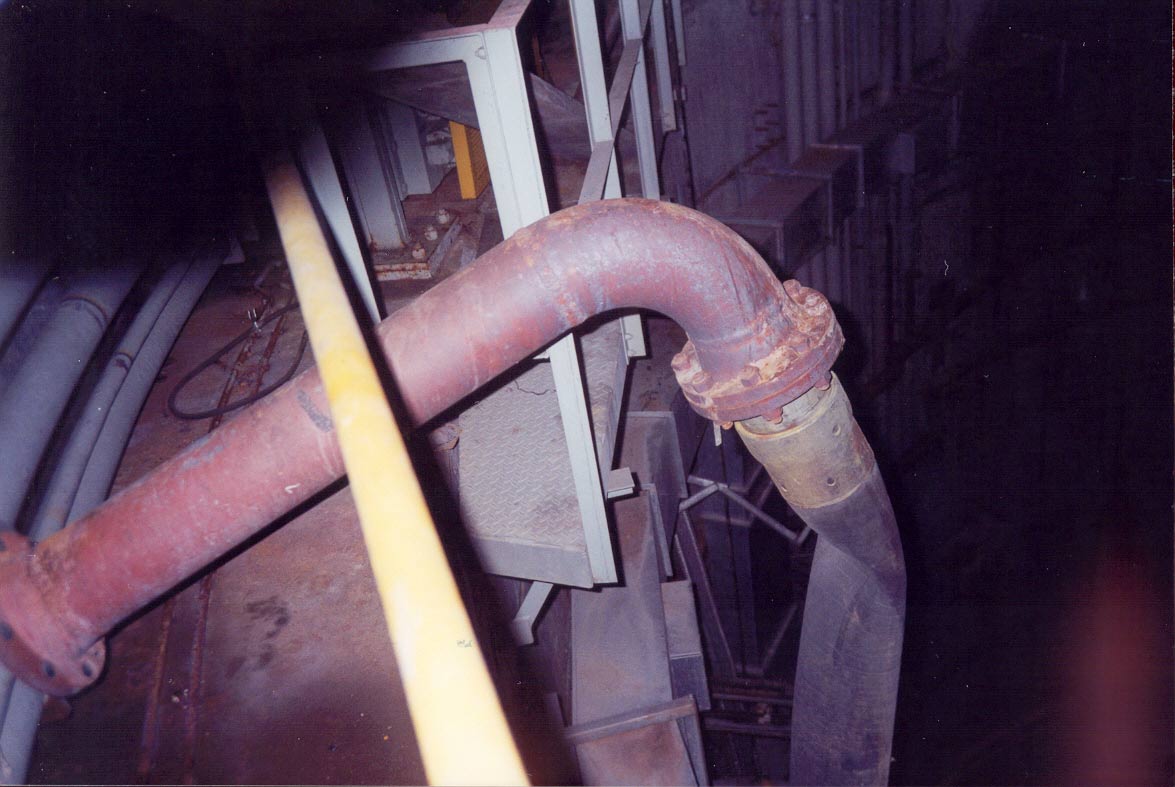
Across
from the twisted pipe connection was this large steel pipe and hose
resting on the railing and hanging into the silo. I believe this
was once part of the launcher #3 silo sump discharge which once purged
all water and any other liquids that accumulated in the silo's sump well
to the surface. Not surprisingly, the soil at each of these sump
discharges was contaminated with VOCs and SVOCs (Volatile Organic
Compounds and Semi-Volatile Organic Compounds) which were readily
detectible over 40 years after site closure and documented in an
environmental study conducted in 1999. VOCs
and SVOCs are compounds such as solvents and other chemicals which
release harmful or irritating gases over time which can be detrimental
to human health. These compounds can persist in the human body for long periods of
time and are demonstrated to readily infiltrate aquifers and as a
result, the food supply. Examples of these compounds are found in
adhesives, paint thinner, lubricants and scores of other compounds
commonly used in industry and which remain a concern of health and
environmental agencies.
|
|
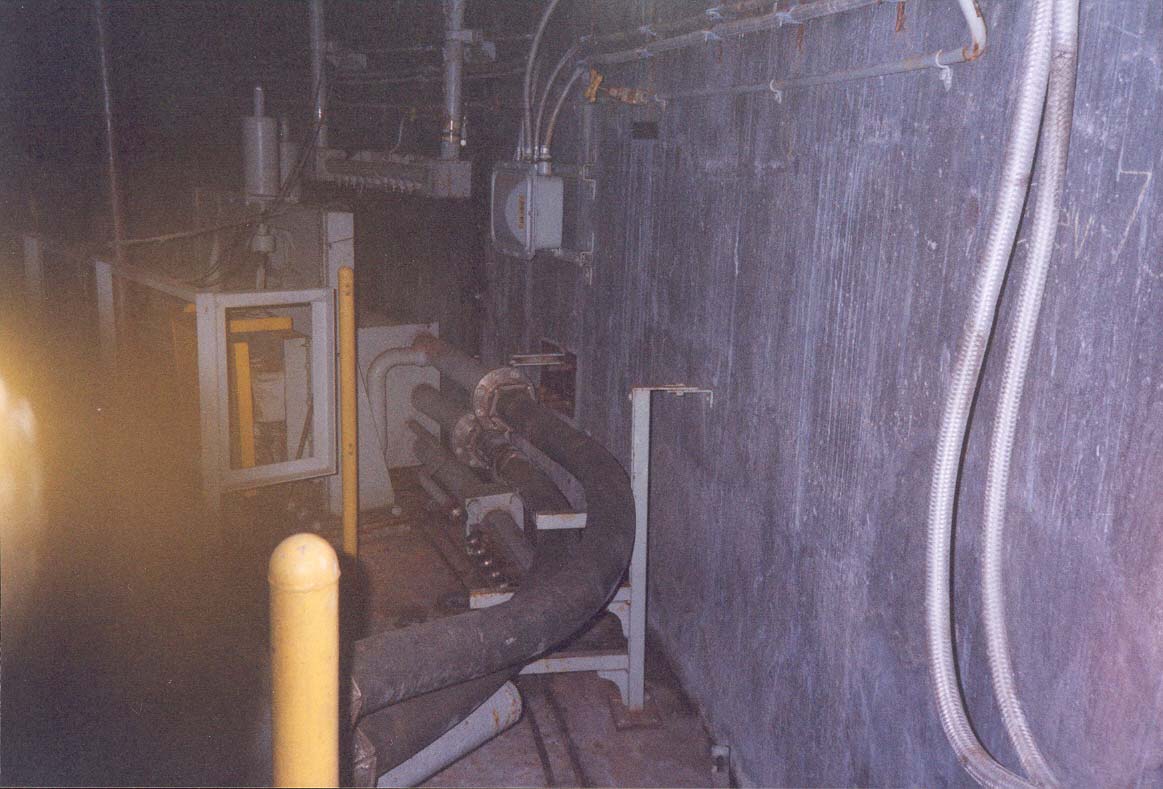
Flexible
hydraulic lines (at center) and electrical lines which are encased in
braided stainless steel. The braided sheathing is most likely to
provide a measure of protection chiefly from explosions, but perhaps
also from heat or fire. Most or all of the electrical lines that
were not in steel conduit in this area were of this sort.
|
Working
my way around the perimeter, I encountered a few obstacles, but mostly
the going was comparatively easy next to getting up to the catwalk
level in the first place. Finally I reached the far end of the
catwalk and made my way back to the elevator motor platform, all the
while dreading the descent I would have to make to escape this cold
war tomb.
|
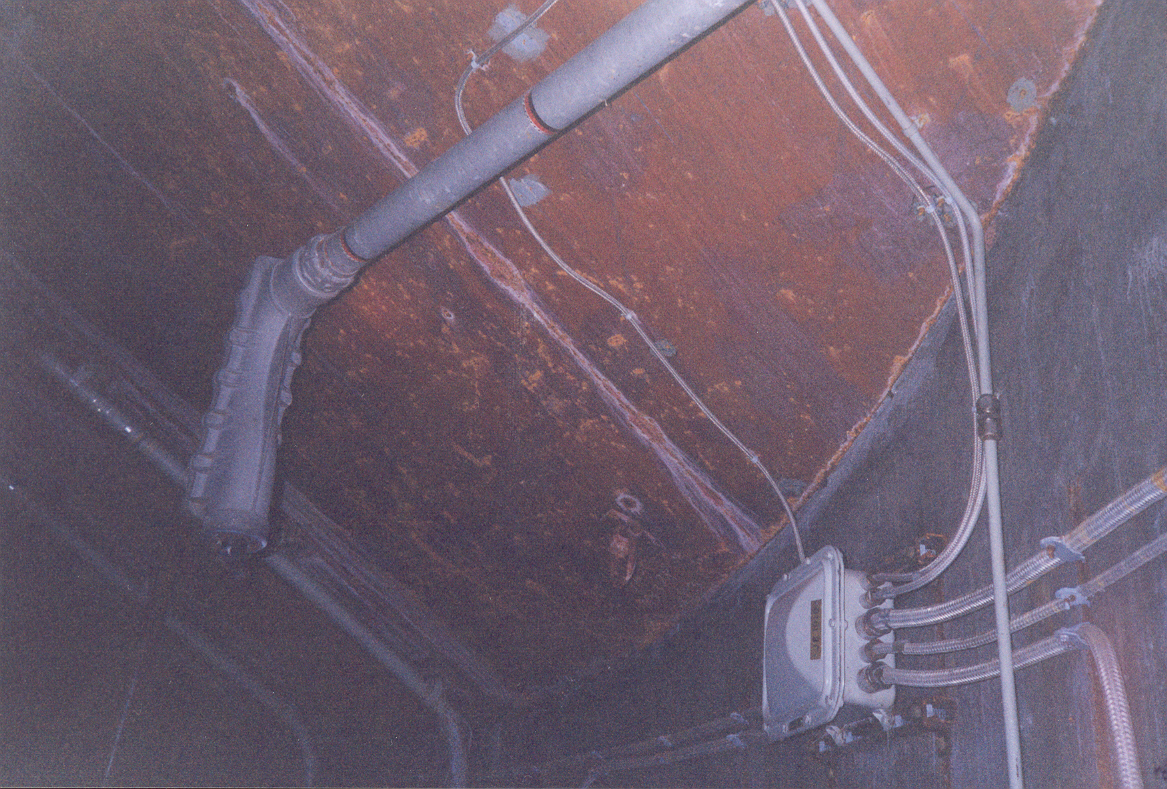
A
very large and very odd-looking section of power conduit. I
believe that this once supplied a large power run to the cribwork in the
form of a flexible lanyard which could move with the structure as it was
leveled and locked. This was probably about a 4" diameter
conduit.
|
|
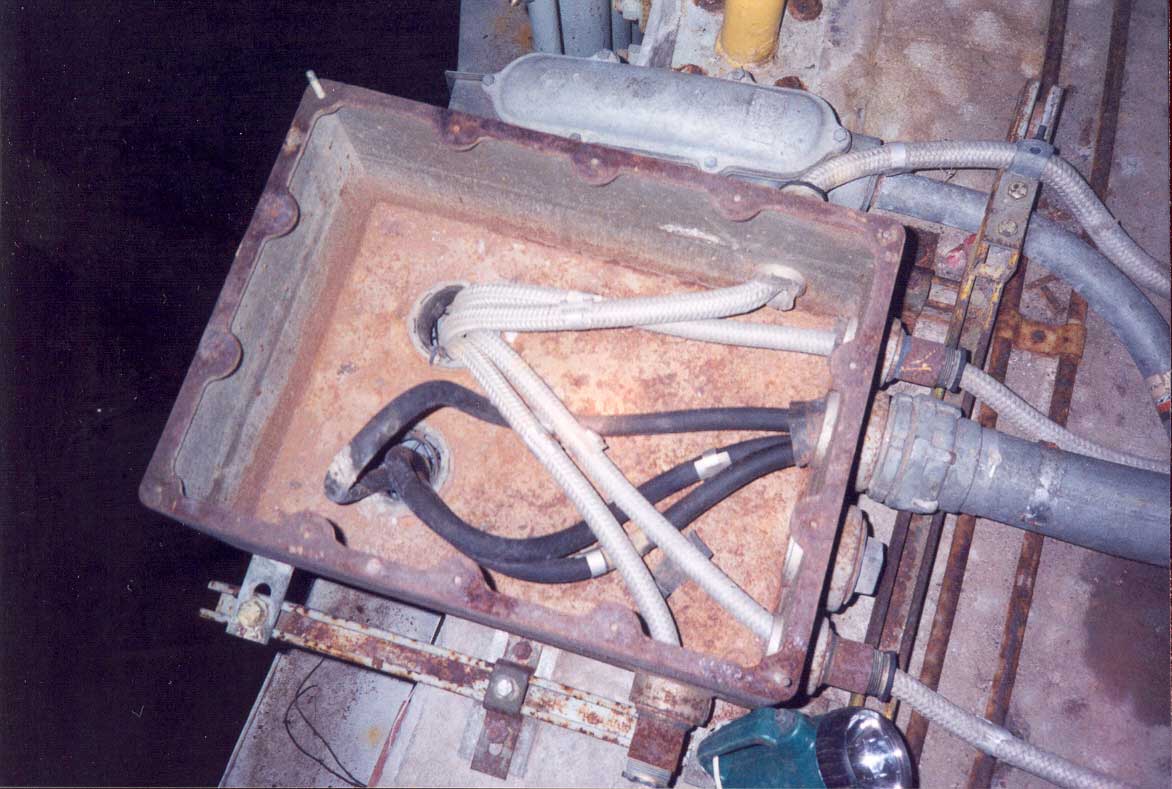
A
very heavy duty electrical junction box at the lip of the silo.
This was made of cast aluminum (I think) about 3/8" thick.
You can see more braided cable running through this box.
|
I
knew that when I went back down I was going to be facing a couple
unpleasant obstacles made all the more unpleasant by the blind
fumbling I would have to do to get past them. I rested for a bit
at the edge of the silo as I planned my departure.
|
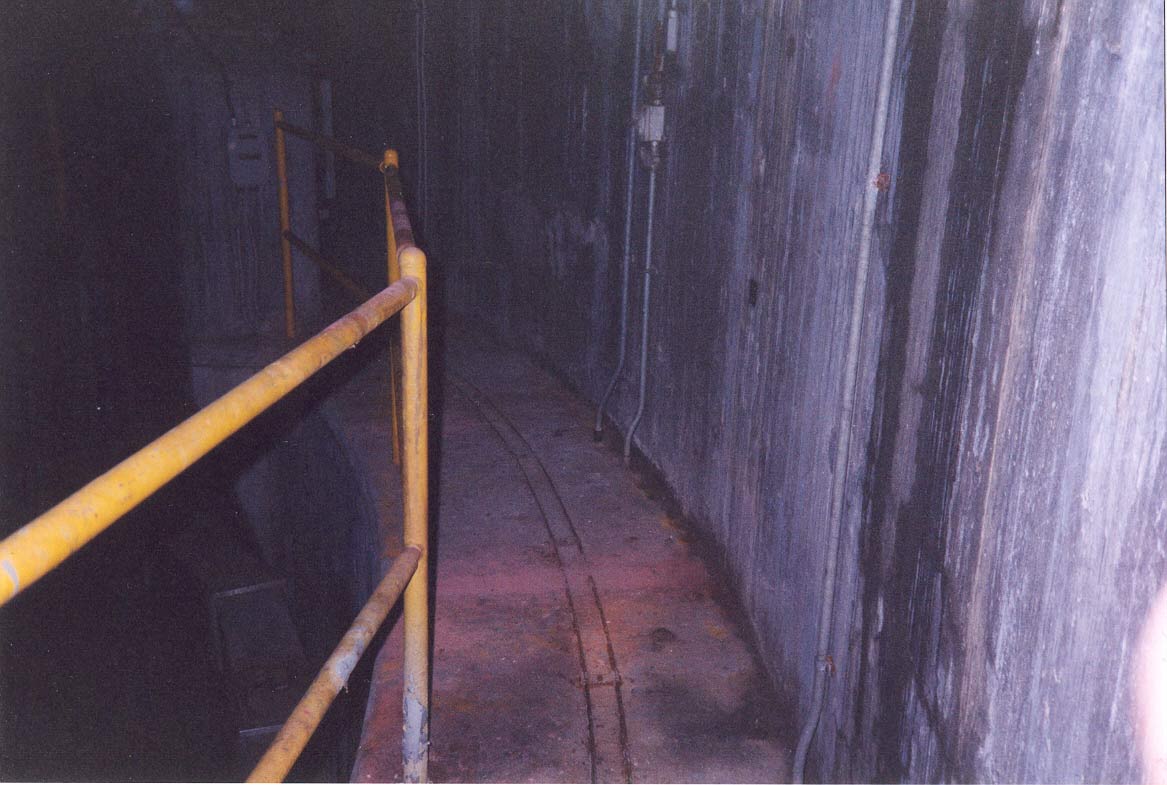
A
rather open and dull section of the catwalk flanked by a flimsy-looking
railing
|
After
sizing up the situation, I set down my flashlight so it shone on the
bolts I had hoisted myself up with earlier and very, very carefully
lowered myself over the edge using the same bolts once again.
Since I could not turn around, I could not see where I was going, so I
spent some incredibly tense moments as my feet fumbled about in the
dark for purchase below me.
|
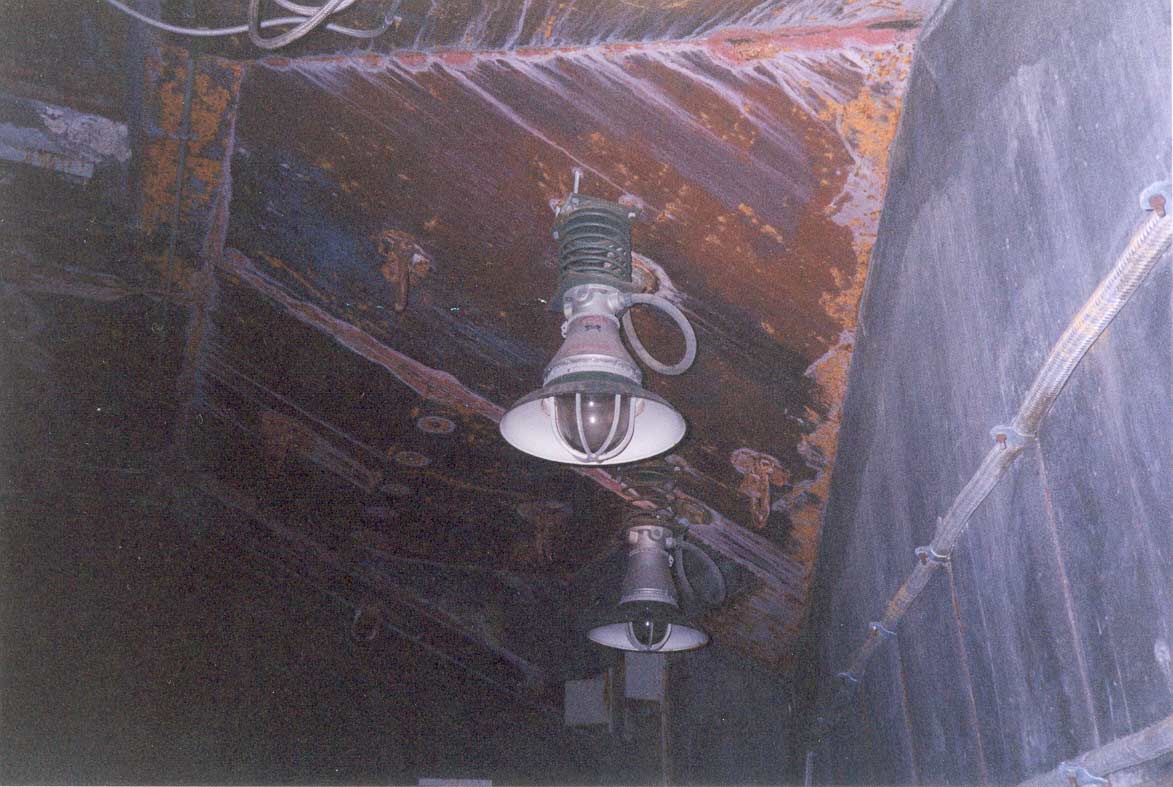
Shock
and explosion-resistant lighting fixtures at the silo cap
|
It
seemed to take forever to find the pipe below as I hung there over the
void looking for a foothold, but I finally found the pipe and relaxed
a bit as I released my white-knuckled grip on the bolt above.
Going down was actually much worse than going up, perhaps because I
was constantly forced to look down at the 5-story drop below me.
That I often could not see where to put my feet for support did not
help at all either.
|
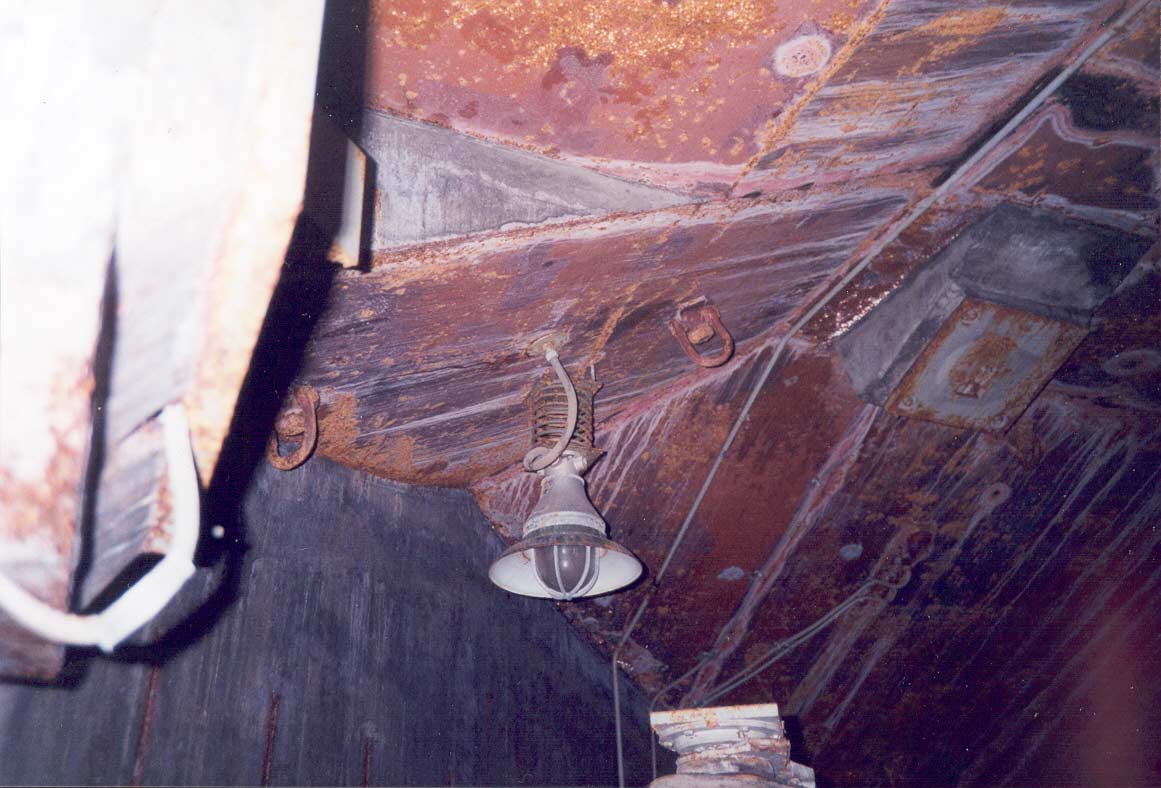
Another
light fixture mounted on the steel plate covered ceiling
|
|
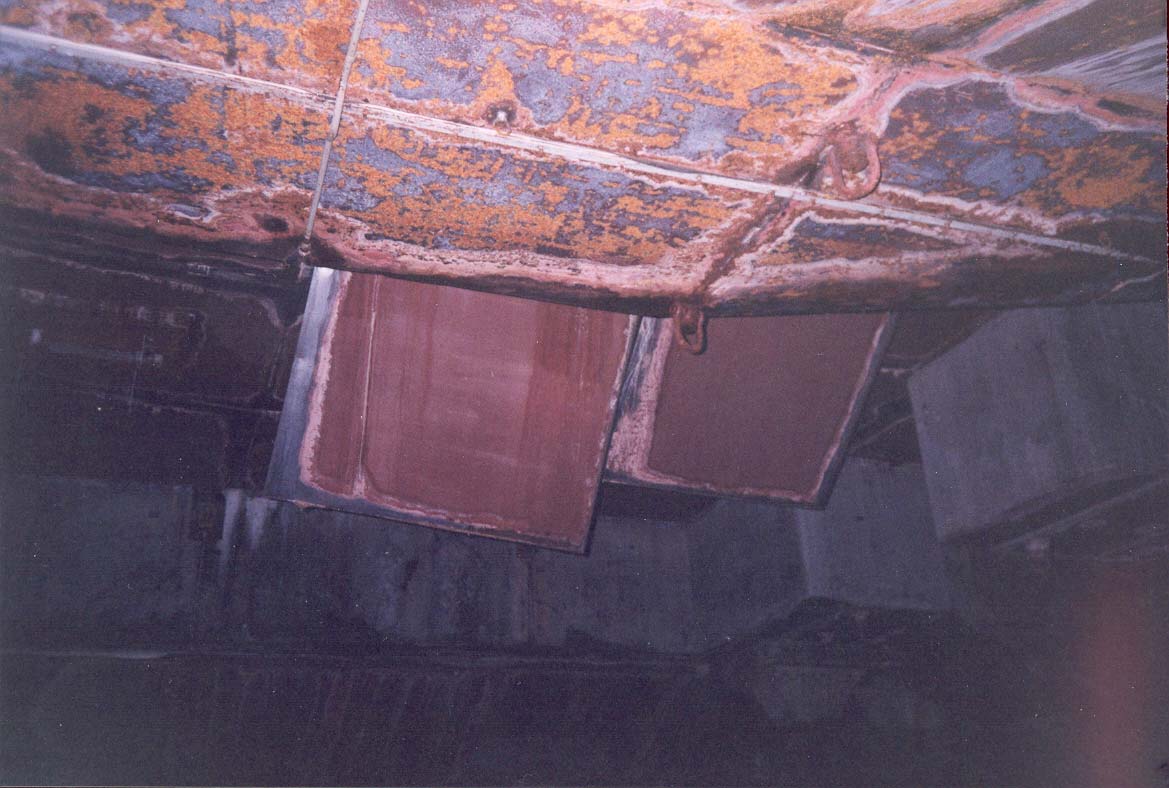
A
shot showing the damaged steel plates on the inside of the silo
doors. These were partially torn loose by drilling through the
silo doors by contractors hired to take water samples from the
silo. I am not sure why the samples were not obtained by entering
the site instead of going through all that trouble.
|
When
I got to the 18" fire water conduit, I had another moment of
terror as I blindly dropped over the edge, desperately searching for
something to stand on below so I could give my aching arms a rest and
feel secure that I was not going to fall into that dark water below.
|
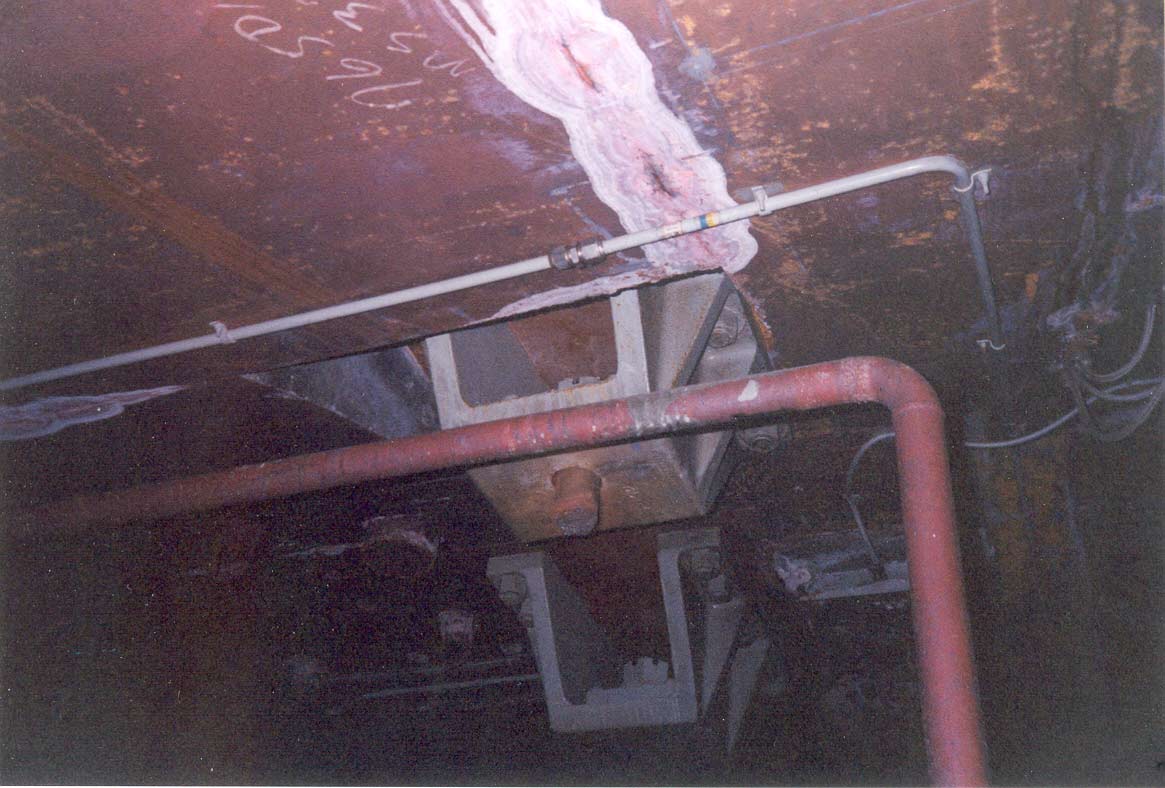
Here
you see two enormous mounting points cast of solid steel and bolted into
the concrete by bolts inches thick. Through the center of each of
these masses of steel runs a bolt almost as thick as a man's arm, held
from above by a nut larger than a softball. These bolts have been
cut off by the salvager's torch, but each once supported one of the four
giant spring suspension assemblies that held the launcher elevator motor
platform. Two more such mounts are found in the adjacent quadrant on
the opposite side of the elevator motor platform.
|
When
I got back down to the counterweight rails, I finally started to relax
a bit, feeling I had escaped death or injury this time in spite of my
incredible foolishness. I knew I had beaten this terrible
obstacle and would live to talk about it. Though its difficult
to understand without being there, take my word for it, it was
exciting to say the least.
Once
back in the personnel tunnel, I marveled at my being alive and swore
to myself never to be so damn stupid and reckless ever again. I
departed joyful and exhilarated at having cheated or escaped
death, (or perhaps I was simply overlooked?) I made my way out
through the rusty throat of the Titan and headed home, certain I would
never repeat such an insane act.
Clearly
I must have a poor memory-- before long I would find myself in a
similar yet even more precarious situation. Some people just
never learn...
|
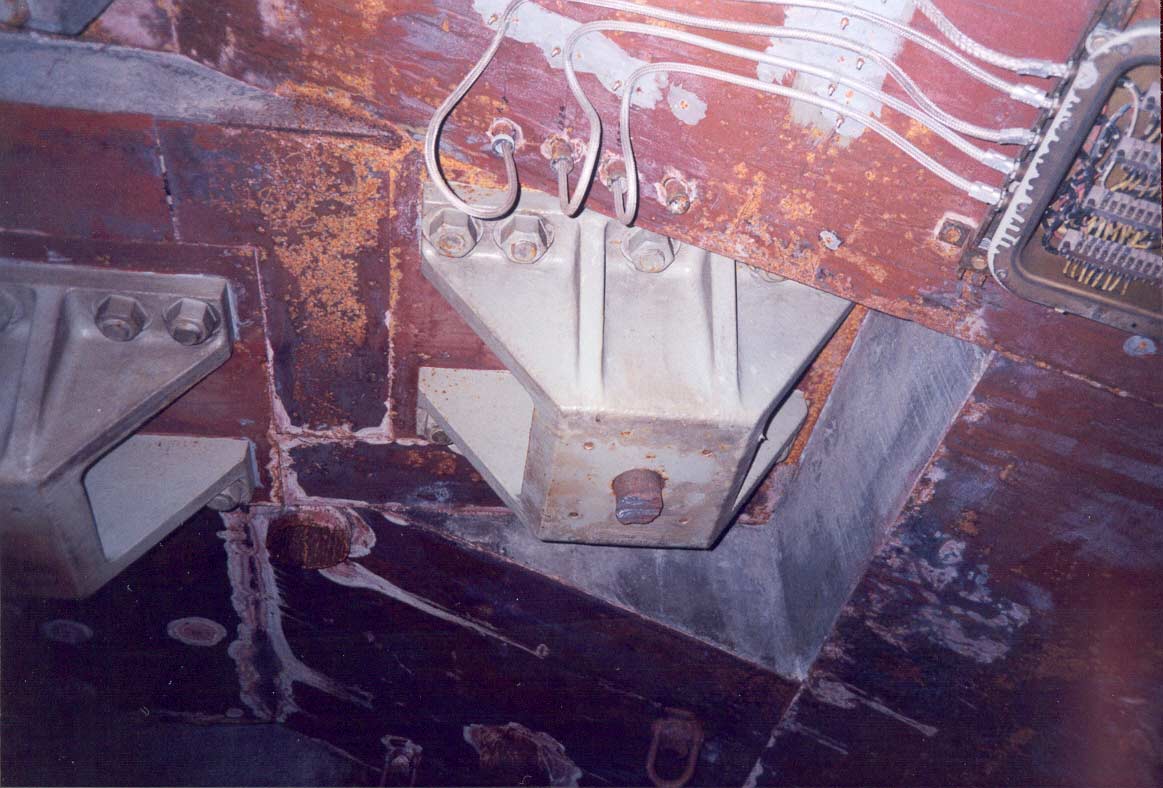
Another
view of the silo cap ceiling and the elevator motor platform spring
assembly mounts. You can see more explosion-resistant wiring entering a
junction box nearby.
|
In
the next section: twice the insanity, twice the idiocy. Yes, its
the climb to the top of Silo #1. Click below to witness the
craziness.
Missile
Silos Part V

| Contact
|
Site Map | Links
|
Hosted by
InfoBunker

